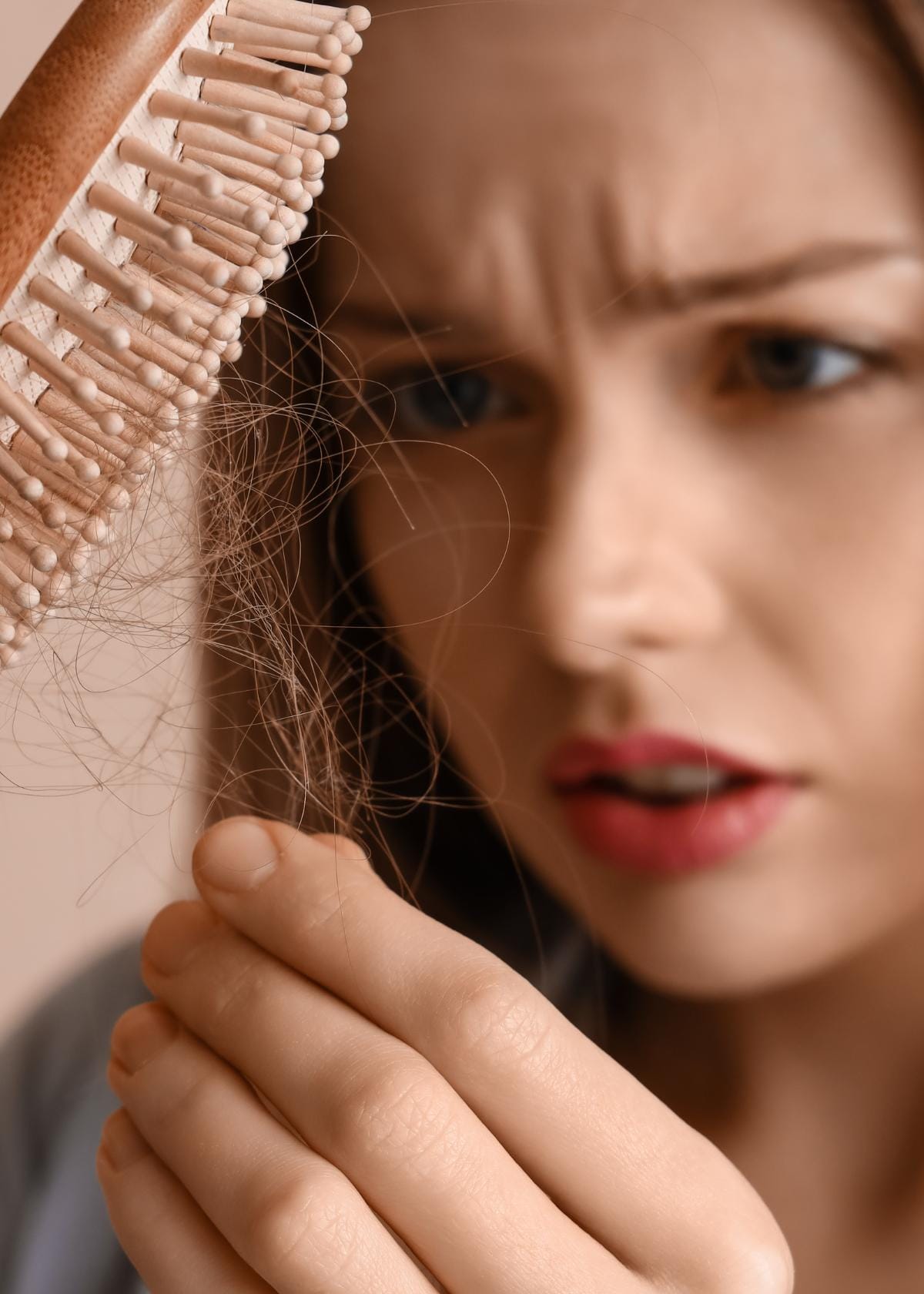Many of us dread the thought of losing our luscious locks at a young age. Did you know that hair thinning can start as early as childhood or during teenage years?
In this blog, I will delve into this often misunderstood phenomenon, shedding light on everything from early signs to potential treatments.
Keep reading; your journey toward understanding hair loss begins right here.
Early Signs of Balding
Thinning hair, receding hairline, and bald spots are the early signs of balding. Let's take a complete look at each of these early signs.
Thinning Hair
Thinning hair often starts subtly. You might notice more strands in your brush or on your pillow. A widening part and smaller ponytails become noticeable signs as it progresses. While it's natural to lose up to 100 hairs a day, excessive loss signals something more serious.
Hereditary factors commonly cause thinning hair, activating during puberty at the earliest in some people. However, hormonal changes due to menopause can also trigger this condition for women specifically.
Less common causes like certain medications or medical conditions might contribute too. Even nutritional deficiencies play a role, surprisingly; lacking sufficient proteins, vitamins, and minerals can lead to unwanted hair loss.
Receding Hairline
Many individuals with thinning hair also experience a receding hairline. This is when the hairline gradually moves backward, creating a more prominent forehead. While it commonly occurs in older men, a receding hairline can also be an early sign of balding in younger individuals.
In fact, about 25% of men who go bald notice their hairline beginning to recede before the age of 21. The progression and severity of a receding hairline can vary from person to person, with some experiencing a more rapid decline than others.
However, regardless of age or rate of progression, it's important to remember that there are treatment options available for those wanting to address this concern and regain confidence in their appearance.
Bald Spots
Bald spots can be a common sign of hair loss and can occur at any age, including in younger individuals. In extreme cases, some people may start experiencing bald spots as early as their teenage years.
Male pattern baldness, one of the main causes of bald spots, can begin in the teens or early 20s. It's important to note that significant hair loss at a young age can be emotionally challenging for both men and women.
If you notice hair loss, bald spots, or thinning hair, it is advisable to consult with a healthcare professional for an accurate diagnosis and appropriate treatment options.
Common Causes of Hair Loss

Hair loss can be caused by a variety of factors, including genetics, hormonal changes, medical conditions, medications, and nutritional deficiencies.
Genetics
Genetics plays a significant role in determining when a person may start experiencing thinning hair. For some individuals, the onset of hair loss can happen as early as childhood or the teenage years.
Male pattern baldness, one of the most common types of hair loss, is often linked to genetic factors and can begin in the teenage years or early 20s. Around 25% of bald men notice their first signs of hair loss before turning 21.
It's important to remember that while genetics contributes to hair loss, there are other causes as well. If you're concerned about your thinning hair and male pattern hair loss at a young age, it's advisable to consult with a healthcare professional for an accurate diagnosis and appropriate treatment options.
Hormonal Changes
Hormonal changes can contribute to hair loss and thinning hair, particularly in women. During puberty, menopause, and other stages of life, when hormone levels fluctuate, it is not uncommon for individuals to notice changes in their hair.
Hormones like estrogen and testosterone play a role in regulating hair growth cycles. When imbalances occur, or sensitivity to certain hormones increases, it can lead to excessive shedding or slower growth.
For example, some women may experience postpartum hair loss due to the drop in estrogen levels after giving birth. Similarly, hormonal disorders such as polycystic ovary syndrome (PCOS) can also result in thinning hair.
Medical Conditions
Medical conditions can play a role in hair loss, particularly at a young age. Certain health issues can contribute to thinning hair or premature balding. Conditions like thyroid disorders, autoimmune diseases, scalp infections, and nutritional deficiencies can all affect the health of your hair follicles and lead to hair loss.
It's important to consult with a healthcare professional if you notice excessive hair shedding or significant changes in your hair thickness and texture, as they can help identify any underlying medical conditions that may be contributing to the problem.
Timely diagnosis and treatment are essential for addressing these medical-related causes of hair loss.
Medications
Medications can play a role in hair loss, particularly if they affect hormone levels or have other side effects that impact hair growth. Some common medications that may contribute to thinning hair include certain antidepressants, blood thinners, and medications used to treat cancer.
It's important to note that not all individuals will experience hair loss as a result of taking these medications, and the extent of hair loss can vary. If you are concerned about medication-related hair loss, it is recommended to speak with your healthcare provider for further evaluation and potential alternative options.
Nutritional Deficiencies
Poor nutrition can also play a role in hair thinning and loss, especially in younger individuals. Nutritional deficiencies, such as inadequate intake of vitamins and minerals essential for healthy hair growth, can contribute to weakened hair follicles and increased hair shedding. Poor nutrition and an unhealthy diet permanently damage hair follicles.
Essential nutrients that support strong and vibrant hair include biotin, vitamin D, iron, zinc, and omega-3 fatty acids. A lack of these nutrients can lead to brittle and thinning hair follicle.
Maintaining a balanced diet rich in these essential nutrients is crucial for promoting healthy hair growth at any age.
At What Age Do Men Typically Start Losing Hair?

Men typically start losing hair in their late teens or early twenties, although it is more common in their thirties and forties.
Can Start in the Late Teens for Some
Thinning hair is not limited to older individuals; it can actually begin in the late teens for some people. While it's uncommon, extreme cases have seen the onset of hair loss as early as age 15.
Male pattern baldness, a common cause of thinning hair, can also start during the teenage years or early twenties. In fact, around 25% of men who experience balding notice the first signs before they turn 21.
It's important to remember that dealing with premature hair loss at a young age can be emotionally challenging and may require professional help for an accurate diagnosis and suitable treatment options.
More Common in 30s and 40s
Hair loss is more commonly seen in individuals in their 30s and 40s. While hair loss can occur at any age, it tends to become more prevalent during this time period. Factors such as genetics, hormonal changes, and the aging process contribute to this increase in hair thinning and balding.
It's important to address these issues early on to prevent further progression of hair loss. Seeking professional advice and exploring treatment options can help manage thinning hair effectively.
Treatment Options for Thinning Hair

There are several treatment options available for individuals experiencing thinning hair, including wigs and toupées, medications such as Finasteride and Minoxidil, as well as hair transplant procedures. Let's take a look at how to treat hair loss, including male hair loss and female pattern baldness.
Wigs and Toupées
Wigs and toupées are popular options for individuals dealing with thinning hair or baldness. They provide a quick and effective way to conceal hair loss, allowing people to regain their confidence and feel more comfortable in their appearance.
Wigs come in a variety of styles, colors, and materials, giving individuals the opportunity to find a look that suits them best. Toupées, on the other hand, are smaller hairpieces that can be attached to existing hair or directly onto the scalp.
Both options offer a non-surgical alternative for those who want to address their thinning hair without undergoing invasive procedures. It's important to note that proper care and maintenance are necessary to ensure longevity and a natural look for wigs and toupées.
Medications (e.g. Finasteride, Minoxidil)
Medications such as Finasteride and Minoxidil are common treatment options for thinning hair. Finasteride, a prescription medication, works by reducing the levels of DHT (dihydrotestosterone) in the scalp, which helps to prevent further hair loss and promote regrowth. These medications help to slow hair loss.
Minoxidil, available over the counter, is applied topically to the scalp and can stimulate hair growth. These medications have been shown to be effective for some individuals in slowing down or reversing the progression of hair loss.
However, it's important to consult with a healthcare professional before starting any medication to determine if it is appropriate for your specific situation.
Hair Transplants
Hair transplants are a surgical procedure that can be an effective treatment option for thinning hair. During the procedure, healthy hair follicles are taken from a donor area and implanted into the areas of the scalp with thinning or no hair.
This allows new hair to grow in those areas and create a more full and natural-looking head of hair. Hair transplants have been successful in treating male pattern baldness, which often starts in the teenage years or early 20s.
It's important to consult with a healthcare professional to determine if a hair transplant is suitable for you and to discuss any potential risks or complications associated with the procedure.
Tips for Healthy Hair and Scalp

Maintain a balanced diet, reduce stress and anxiety, and establish a consistent hair care routine. Read on to discover more ways to keep your hair healthy and prevent thinning.
Maintaining a Balanced Diet
Eating a balanced diet is crucial for overall health, and it can also play a role in maintaining healthy hair. Nutritional deficiencies can contribute to hair thinning and loss, so ensuring that you are getting the right nutrients is important.
Incorporate foods rich in vitamins A, C, E, and Biotin into your daily meals. These nutrients are essential for promoting healthy hair growth and preventing hair breakage. Additionally, include sources of protein like lean meats, eggs, and beans, as they provide the building blocks for strong and healthy strands.
Remember to stay hydrated by drinking plenty of water throughout the day as well.
Reducing Stress and Anxiety
Reducing stress and anxiety is crucial for maintaining healthy hair and preventing hair loss. High levels of stress can disrupt the normal hair growth cycle, leading to increased shedding or even premature hair loss.
Finding effective ways to manage stress, such as practicing relaxation techniques like deep breathing or meditation, exercising regularly, getting enough sleep, and engaging in activities that bring joy and relaxation, can positively impact both your mental well-being and the health of your hair.
It's important to prioritize self-care and implement stress-reducing strategies into your daily routine to promote a healthier scalp and fuller-looking locks.
Consistent Hair Care Routine
Taking care of your hair and scalp is essential in maintaining healthy hair and preventing further thinning or hair loss. Establishing a consistent hair care routine can help nourish your strands, promote scalp health, and minimize damage.
This includes regular washing with mild shampoos suitable for your hair type, followed by conditioning to keep your locks hydrated and manageable. Additionally, using products that protect against heat styling and UV damage can prevent further harm to the hair follicles.
Finally, incorporating gentle scalp massages into your routine can stimulate blood flow to the scalp, promoting healthier hair growth.
Frequently Asked Questions
Hair thinning and loss can happen at any age, but it often starts for people in their late teens, 20s, or 30s. If you've noticed your hair thinning at a young age, you likely have questions about the causes, treatments, and what you can expect going forward.
Below are some frequently asked questions about early onset hair thinning and loss, including information on the youngest age it can start, the difference between male and female hair loss, treatment options, and advice for coping.
Are there any early signs of baldness in teenagers?
Yes, hair thinning in the scalp area and excessive hair shedding are common early signs of balding that could occur during adolescence or young adulthood.
How does genetic influence factor into youth experiencing hair loss?
Genetics plays a significant role in determining if adolescents will experience premature onset of hair loss, known as male pattern baldness for boys.
Can children also experience hair loss at an early age?
Absolutely. Child hair loss exists and isn't restricted to older individuals; however, it's less common than thinning hair or balding in your 20s.
Is teenage or adolescent onset thinning entirely different from age-related hair thinning?
The primary difference between these two is timing; while age-related thinning typically begins later in life, teenager or adolescent-onset thinning happens much earlier due to various factors like genetics and health conditions.
What is alopecia, and when can it start affecting teenagers?
Alopecia, a term for hair loss, can potentially affect teenagers as early as their adolescent years and may show signs of balding. Some people often confuse it with androgenetic alopecia.
Conclusion
Thinning hair can start as early as childhood or the teenage years, although it is unusual for men to begin losing their hair in their teens. Male pattern baldness, a common cause of hair loss, can begin in the teenage years or early 20s.
It's important to remember that hair loss at a young age can be emotionally challenging, and it's always best to seek professional advice for an accurate diagnosis and suitable treatment options.
Read More About Other Related Topics Of Your Interest






